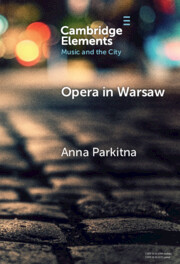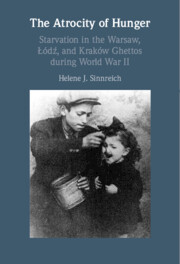Refine search
Actions for selected content:
23 results
10 - Cultural Activity in the Holocaust
-
-
- Book:
- The Cambridge History of the Holocaust
- Published online:
- 16 May 2025
- Print publication:
- 12 June 2025, pp 163-184
-
- Chapter
- Export citation
17 - Jews in Armed Resistance Movements and Partisan Units
-
-
- Book:
- The Cambridge History of the Holocaust
- Published online:
- 16 May 2025
- Print publication:
- 12 June 2025, pp 281-299
-
- Chapter
- Export citation

Opera in Warsaw
- A City of the European Enlightenment
-
- Published online:
- 27 November 2024
- Print publication:
- 19 December 2024
-
- Element
- Export citation
Introduction
-
- Book:
- The Atrocity of Hunger
- Published online:
- 09 February 2023
- Print publication:
- 16 February 2023, pp 1-16
-
- Chapter
-
- You have access
- Open access
- HTML
- Export citation

The Atrocity of Hunger
- Starvation in the Warsaw, Lodz and, Krakow Ghettos during World War II
-
- Published online:
- 09 February 2023
- Print publication:
- 16 February 2023
-
- Book
-
- You have access
- Open access
- Export citation
6 - Religious Populism and Its Opponents
-
- Book:
- Cross Purposes
- Published online:
- 08 December 2022
- Print publication:
- 22 December 2022, pp 243-301
-
- Chapter
- Export citation
1 - The Ascendance of the Cross
-
- Book:
- Cross Purposes
- Published online:
- 08 December 2022
- Print publication:
- 22 December 2022, pp 27-62
-
- Chapter
- Export citation
5 - Information Wars
-
- Book:
- Survivors
- Published online:
- 27 January 2022
- Print publication:
- 17 February 2022, pp 140-168
-
- Chapter
- Export citation
2 - The Killing Years
-
- Book:
- Survivors
- Published online:
- 27 January 2022
- Print publication:
- 17 February 2022, pp 48-79
-
- Chapter
- Export citation
8 - Spoiling for a Fight
-
- Book:
- Survivors
- Published online:
- 27 January 2022
- Print publication:
- 17 February 2022, pp 226-253
-
- Chapter
- Export citation
1 - Warsaw Besieged
-
- Book:
- Survivors
- Published online:
- 27 January 2022
- Print publication:
- 17 February 2022, pp 22-47
-
- Chapter
- Export citation
9 - Home Army on the Offensive
-
- Book:
- Survivors
- Published online:
- 27 January 2022
- Print publication:
- 17 February 2022, pp 254-277
-
- Chapter
- Export citation
7 - Matters of Faith
-
- Book:
- Survivors
- Published online:
- 27 January 2022
- Print publication:
- 17 February 2022, pp 192-225
-
- Chapter
- Export citation
3 - Pawiak Prison
-
- Book:
- Survivors
- Published online:
- 27 January 2022
- Print publication:
- 17 February 2022, pp 80-104
-
- Chapter
- Export citation
6 - School of Hard Knocks
-
- Book:
- Survivors
- Published online:
- 27 January 2022
- Print publication:
- 17 February 2022, pp 169-191
-
- Chapter
- Export citation
4 - The Warsaw Ghetto
-
- Book:
- Survivors
- Published online:
- 27 January 2022
- Print publication:
- 17 February 2022, pp 105-139
-
- Chapter
- Export citation
THE HISTORY OF BILINGUAL DICTIONARIES RECONSIDERED: AN ANCIENT FRAGMENT RELATED TO PS.-PHILOXENUS (P.VARS. 6) AND ITS SIGNIFICANCE
-
- Journal:
- The Classical Quarterly / Volume 71 / Issue 1 / May 2021
- Published online by Cambridge University Press:
- 21 May 2021, pp. 359-378
- Print publication:
- May 2021
-
- Article
-
- You have access
- Open access
- HTML
- Export citation
15 - Carmen in Poland prior to 1918
- from Part II - Across Frontiers
-
-
- Book:
- <I>Carmen</I> Abroad
- Published online:
- 18 September 2020
- Print publication:
- 30 July 2020, pp 230-244
-
- Chapter
- Export citation
15 - Operetta in Warsaw
- from Part III - Operetta since 1900
-
-
- Book:
- The Cambridge Companion to Operetta
- Published online:
- 14 November 2019
- Print publication:
- 05 December 2019, pp 232-245
-
- Chapter
- Export citation
III - The Private at War
-
- Book:
- Private Life and Privacy in Nazi Germany
- Published online:
- 28 June 2019
- Print publication:
- 18 July 2019, pp 231-352
-
- Chapter
- Export citation
